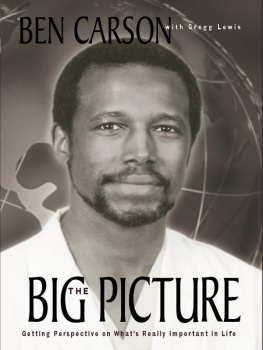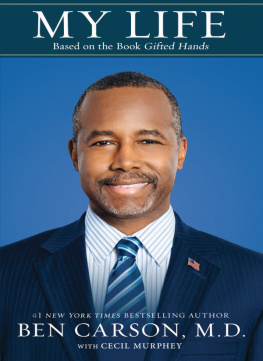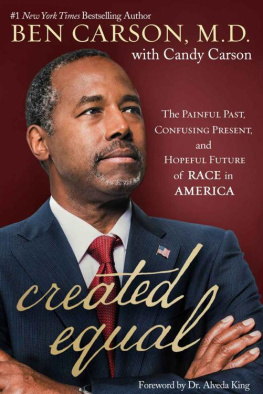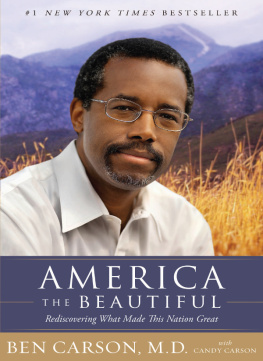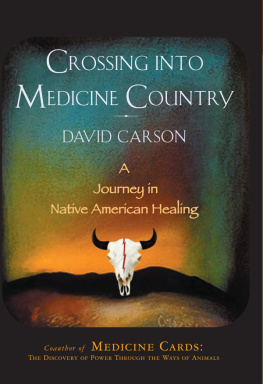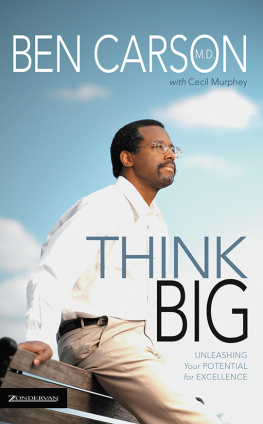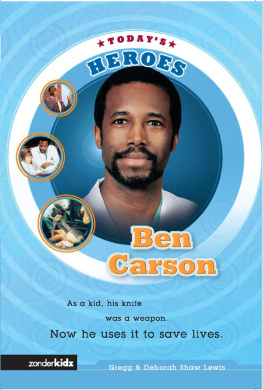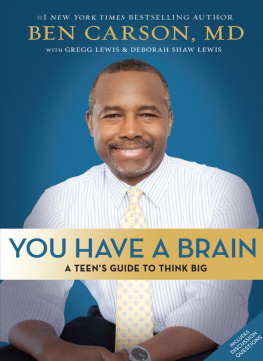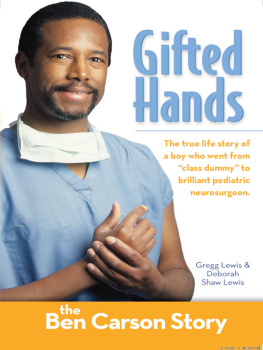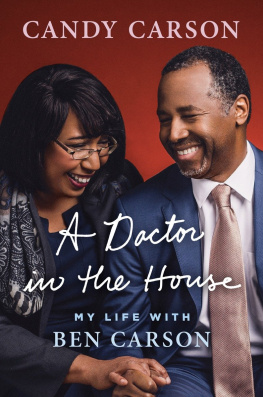
Other books by Dr. Benjamin Carson
Gifted Hands: The Ben Carson Story (with Cecil Murphey)
Think Big: Discovering Your Gift of Excellence (with Cecil Murphey)

ZONDERVAN
THE BIG PICTURE
Copyright 1999 by Benjamin Carson
Photo insert 2000 by Benjamin Carson
All rights reserved under International and Pan-American Copyright Conventions. By payment of the required fees, you have been granted the non-exclusive, non-transferable right to access and read the text of this e-book on-screen. No part of this text may be reproduced, transmitted, down-loaded, decompiled, reverse engineered, or stored in or introduced into any information storage and retrieval system, in any form or by any means, whether electronic or mechanical, now known or hereinafter invented, without the express written permission of Zondervan.
ePub Edition July 2009 ISBN: 978-0-310-85796-9
Requests for information should be addressed to:
Zondervan, Grand Rapids, Michigan 49530
Library of Congress Cataloging-in-Publication Data
Carson, Ben.
The big picture: getting perspective on whats really important in life / Ben Carson with Gregg Lewis.
p. cm.
ISBN-13: 978-0-310-85796-9
1. Christian life. 2. Carson, Ben. I. Lewis Gregg, 1951-. II. Title.
BV4501.2.C272 1999
617.480083dc21
98-32033
CIP
All Scripture quotations, unless otherwise indicated, are taken from the Holy Bible: New International Version. NIV. Copyright 1973, 1978, 1984 by International Bible Society. Used by permission of Zondervan Publishing House. All rights reserved.
All rights reserved. No part of this publication may be reproduced, stored in a retrieval system, or transmitted in any form or by any meanselectronic, mechanical, photocopy, recording, or any otherexcept for brief quotations in printed reviews, without the prior permission of the publisher.
05 06 07 08 09 10 27 26 25 24 23 22 21 20
To Bill and Shirley Howard
and the Childrens Cancer Foundation
for making my life easier,
and to Gary Roth,
a friend, a patient,
and an inspiration to me.
CONTENTS
Part One
SEEING THE BIG PICTURE
TWO DAYS AFTER CHRISTMAS, on the evening of December 27, 1997, I kissed my wife and three sons good-bye, walked out the door of our suburban Maryland home, and headed for Baltimore-Washington International Airport. From there I flew to New York to connect with a transcontinental flight bound for South Africa.
As the 747 lumbered down the runway, lifted slowly into the air, and banked out over the Atlantic I knew I had sixteen long hours to rest and review my notes and finalize plans for what I hoped and prayed might be a history-making endeavor.
I leaned my head back, closed my eyes, and tried to remember everything I had learned about the case of Joseph and Luka Banda. The Banda boys were eleven-month-old Siamese twins joined at the top of the head, facing opposite directions.
All Siamese twins joined at the head are known as craniopagus twins (for the Greek cranio, meaning helmet, and pagus, meaning fixed). Before 1987, only seventy-nine such cases were recorded in five hundred years of medical history.During that time, thirty attempts had been made to separate them. Only seven of the sixty children survived unscathed.Thirty had died during or soon after the surgeries, and seventeen were neurologically impaired. Reports on the remaining cases were incomplete.
Despite the historically bleak prognosis for separating craniopagus Siamese twins, I hoped to accomplish something with these boys that had never been done before. I wanted to give both Joseph and Luka Banda a chance to live normal lives. But I knew that in a few short hours that chance, like their lives and their futures, would rest in my hands. Literally.
This was not the first time I had faced such a challenge. Despite the extreme rarity of this condition, the Banda twins were my third personal encounter with craniopagus Siamese twins in less than a decade. In 1987 I had received a great deal of publicity from the national and international media when I led a team of surgeons at Johns Hopkins in the successful separation of twins who had been attached at the back of the head. Both boys had survived, although one of them sustained significant neurological damage. (Patrick and Benjamin Binders story was previously told in the book Gifted Hands.)
The second set of Siamese twins I encountered in 1994, three years before the Banda twins were even born. It is the story of those two girls that follows.
One
THE SOUTH AFRICAN TWINSWHY?
ONE DAY IN JANUARY 1994 I received a long-distance call at work.I think you need to talk to this gentleman, my office manager told me. So I picked up the phone.
Dr. Benjamin Carson? I could not place the accent, but having spent a year living and working in Australia, I immediately recognized the proper British influence in the mans careful enunciation.
This is Dr. Carson, I told him.
I am so pleased to speak to you, Dr. Carson, the man said. My name is Dr. Samuel Mokgokong. I am professor of neurosurgery at the Medical University of South Africa at Medunsa. Now the accent fit.
How may I help you?
Dr. Mokgokong quickly explained that he had under his care a set of South African Siamese twins whose case seemed similar to that of the Binder twins, whom I had helped separate seven years earlier. Because of that successful surgery, Dr.Mokgokong was hoping I would be willing to consult with him and perhaps even participate in the separation of his patients.
I told him that I would be glad to consult with him if he could provide me with copies of his case records. That immediate response was prompted by more than just the usual professional courtesy. My experience with the Binder twins had not only been a major turning point, a defining moment in my professional career, it had been one of the greatest medical challenges I had ever known. At the time I had considered it a once-in-a-lifetime opportunity.
And now, seven years later, from a call out of the blue and half a world away, I receive word about a second set of craniopagus Siamese twins. Of course I was interested. But I was not at all sure just how involved I should be or could be in a case as demanding and complex as this on the other side of the world.
Dr. Mokgokong informed me he would be making a trip to the United States within the month and could bring all the necessary records for me to review. I agreed to meet with him at Johns Hopkins in Baltimore, and we set a tentative date for his visit.
And so the South African neurosurgeon left Johannesburg in the heat of summer in the Southern Hemisphere to make his mid-winter journey to North America. Everything about himfrom his deep resonant voice to his quick smileconveyed such a friendly openness that I couldnt help but like Sam Mokgokong from the start. Slightly balding, about forty, he stood two or three inches short of my six feet yet outweighed me by more than fifty pounds. I could not help thinking that given his build and personality, he would make a wonderful African Santa Clausall he needed was a white beard.
We struck up an almost immediate friendship. When we began discussing his case, I was soon as impressed with him professionally as I was personally, for he asked the right questions and seemed to have arrived at most of the right conclusions already.
Next page
